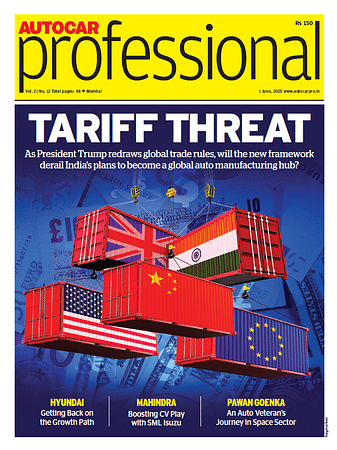Need to View Lightweighting from ‘What’ to ‘How’: Anand Kulkarni of Tata Motors
Why Tata Motors’ Anand Kulkarni believes the future of lightweighting lies not in exotic materials, but in scalable, smart integration across EV systems.
In the pursuit of cleaner, more efficient mobility, lightweighting has long been considered a fundamental lever. From high-strength steels to aluminum and carbon fibre composites, the conversation around materials is hardly new. And yet, as Anand Kulkarni, Chief Product Officer – Passenger Electric Mobility at Tata Motors, suggests, maybe it's time to change the question.
“We’ve talked about lightweighting materials for years—ultra-high-strength steels, aluminum, magnesium, plastics, carbon composites,” Kulkarni says. “What’s needed now is to pivot from what these technologies are to how we implement them at scale.”
That shift from material discovery to material deployment is increasingly vital. The problem isn’t one of awareness, but of integration, economics, and execution.
The Lightweighting Matrix: Cost vs. Mass
Kulkarni frames the challenge through a simple yet effective two-by-two matrix—cost vs. weight. “No one’s going to pursue a solution that is both high-cost and high-weight. That’s a non-starter. The real win lies in achieving low weight without significant cost escalation.”
This matrix becomes a critical filter in evaluating lightweighting technologies. A solution that merely reduces weight but adds disproportionately to the cost can render itself commercially unviable, especially in the competitive mass-market segments in which Tata Motors operates.
Layered Complexity in EV Architecture
Electric vehicles add their own set of architectural complexities. Kulkarni lays this out across four foundational layers:
- Powertrain – propulsion system, batteries, and power electronics
- Chassis – structural backbone
- Electrical & Electronic Architecture – sensors, radars, actuators
- Cloud & Software Layer – digital interface and over-the-air capabilities
“Lightweighting has no role to play in the virtual cloud layer. But the first three layers—powertrain, chassis, and electronics—offer plenty of opportunities.” In the powertrain, for instance, early EVs relied on multiple discrete components: motors, inverters, gearboxes, on-board chargers, DC-DC converters, and more. But this siloed approach is being replaced by a trend of multi-in-one integration.
“We’ve seen 6 components go to 3-in-1 combos, and now 6-in-1 or even 9-in-1 units are emerging,” he adds. “This reduces weight, improves geometric packaging, and boosts reliability.”
Integration as Innovation
Kulkarni believes that integration—both digital and mechanical—is one of the most powerful enablers of lightweighting today. It reduces not just part count and mass but also system complexity.
“Weight reduction from integration alone can be as high as 25kg in some setups,” he points out. “And the business case becomes stronger in a post-COVID, post-semiconductor disruption world.”
Domain controllers in E/E architecture serve a similar role—streamlining multiple ECUs into fewer, high-functionality control units. This functional convergence is driving weight savings across the electrical layer as well.
The Cost Curve of Materials
Cost has traditionally been a barrier for advanced lightweight materials. But even that is changing. Aluminum, for example, has held relatively steady in raw price over the last 15 years—yet processing costs have dropped by up to 60–70%.
Similarly, carbon fibre, once restricted to motorsports, is now making limited but meaningful inroads into premium production vehicles. “It’s not mainstream yet,” Kulkarni admits, “but scale and manufacturing maturity are changing the game.”
Skateboard Platforms & Structural Rethink
For EVs, the move toward bespoke ‘skateboard’ platforms has unlocked new design freedom. With no need for driveshafts or conventional floor structures, weight-saving possibilities abound.
“Designing the car around the battery, rather than adapting ICE platforms, is the way forward,” Kulkarni says. “It changes how we handle crash structures, torsional stiffness, and vibration management.”
Kulkarni’s view is clear: lightweighting is not just a technical goal, it is an economic and integration challenge. The shift from exotic to accessible, from what to how, is what will define the next decade of mobility engineering.
“Technology for technology’s sake won’t work. We must ensure that lightweighting delivers value, not just novelty.” As the Indian auto industry marches toward an electric and sustainable future, voices like Kulkarni’s bring much-needed clarity: real progress lies in scalable, system-level solutions—not just in new materials, but in more innovative implementation.
RELATED ARTICLES
Auto Skilling in India Demands Strong Curriculum Correction, Says ASDC CEO
ASDC is working with higher education institutions to introduce short-duration elective programs for students to prepare...
AI’s Biggest Contribution to Automotive Development Will Be Reducing Turnaround Times: Tata Technologies
Artificial intelligence is transforming vehicle engineering by accelerating design automation and reducing development t...
Toyota Kirloskar Motor Launches 3-Month EMI Holiday Scheme for Glanza and Hyryder Models
Customers can purchase vehicles immediately and begin EMI payments during Navratri season.





 12 Jun 2025
12 Jun 2025
 1343 Views
1343 Views





 Yukta Mudgal
Yukta Mudgal


 Prerna Lidhoo
Prerna Lidhoo

 Shruti Shiraguppi
Shruti Shiraguppi

